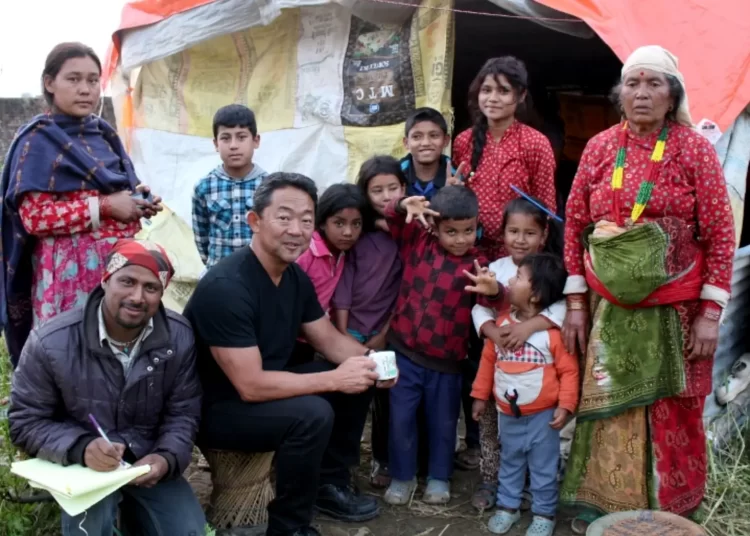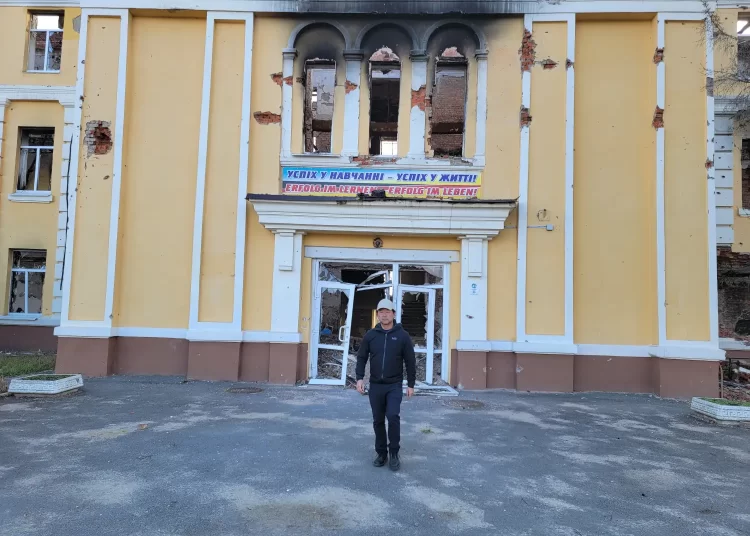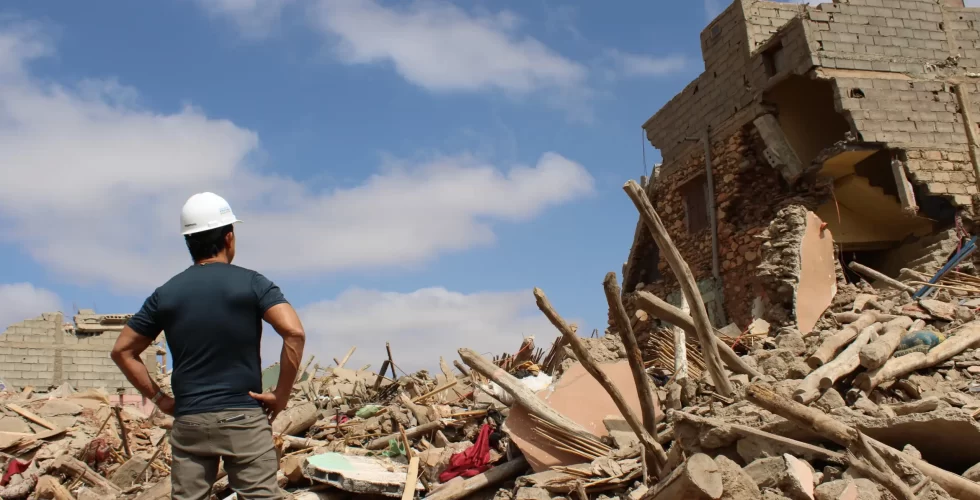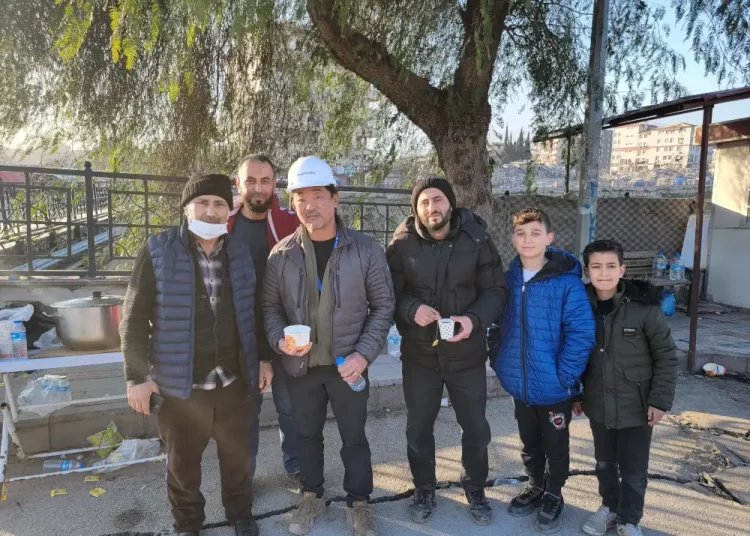From Earthquake Reconstruction to the Battlefield: An Engineer Helps Rebuild Buildings Around the World
by Hidetoshi Oshima
Originally published in Mainichi Shimbun on October 7th, 2023
Four cruise missiles and about 10 drones flew into the night sky of Kyiv, Ukraine, causing an eerie, body-shaking “boom” to echo through the area. Although Ukrainian military interceptors shot down all the missiles and drones, the relentless air raids that tore through the silent night reminded us once again that we were in a war zone. Dr. Kit Miyamoto, CEO of a Los Angeles-based global engineering and disaster reconstruction firm, Miyamoto International, visited Ukraine in early July of 2023. “Every time an alarm sounds, the citizens are tense and the daily air raids make it hard to sleep,” he said. “There is actual damage from the attacks, but I think the psychological impact is also significant”.
In September 2022, he visited the area near Bucha, where the massacre by Russian troops is said to have taken place. He was outraged by the inhumanity of the act. “I have seen cities uprooted and destroyed by Russian military. We learned of women who had been assaulted, of elderly fathers who had been killed for no reason. Every time I saw the unnecessary destruction, it made me sick”

A request flown in from a UN agency
When the invasion of Ukraine began in February 2010, he felt compelled to do something for those whose lives had been shattered for no reason. In September 2010, while searching for an opportunity to visit Ukraine, he received a request from the United Nations Office for Project Services (UNOPS), which is responsible for infrastructure construction in conflict zones and dangerous areas, to inspect the condition of buildings in Ukraine. He and his team immediately flew to the site and took on the task of assessing the condition of destroyed housing complexes and other structures. Miyamoto International is still working on restoring approximately 10,000 homes, schools, and other structures. He has spent more than 100 days in Ukraine over the past year. Due to the high risk involved, he says, “I see very few private companies from foreign countries.”
Miyamoto International (MI) is a global company with branches and offices in 30 locations worldwide, employing around 500 people. Dr. Kit Miyamoto, who holds a doctorate from Tokyo Institute of Technology, currently serves as a commissioner for the California Seismic Safety Commission.
MI was entrusted by the United Nations Office for Project Services (UNOPS) to restore buildings in Ukraine due to its extensive experience in disaster recovery efforts worldwide and its close collaboration with local communities.
Over the past 16 years, Dr. Miyamoto has visited 14 disaster-stricken areas. In major earthquakes, the structural system of buildings is often fundamentally damaged. His primary responsibility is to rush to the site as soon as possible, diagnose the building’s condition, and pave the way for restoration. He has firsthand experience with the risks involved. “The most frightening thing is aftershocks,” he said. “They strike all weakened buildings.” The danger of being caught in a collapse is always present.
Around 1993, Dr. Miyamoto began to make his mark in the United States. He incorporated the latest earthquake-resistant technology into his designs in the West Coast region, which is also an earthquake-prone area, and built up a solid track record.
The Sichuan Earthquake in China that Changed the Company
In 2008, the Sichuan Earthquake hit China, leaving 87,000 people dead or missing, and many school buildings collapsed. The question was, “Why did they collapse? If we don’t somehow determine the cause, future generations will not be able to help.” At the time, the Chinese government was unwilling to allow foreign engineers to enter the country, but Dr. Miyamoto forced his way into the country. After spending about two weeks inspecting more than 10 schools, he found that the three- to five-story school buildings had all collapsed, and about 1,000 students were crushed to death.
Frantically examining the building structure, he found that the massive concrete floor was poorly supported by brick-only pillars. After the inspection, the findings and reinforcement methods were published on the Internet as a “technical report”. Its contents were translated into Chinese and disseminated.
One year after seeing the site in China, the company adopted “make the world a safer and better place” as its company motto. Dr. Miyamoto also utilized the methods of “cultural anthropology,” in which one becomes a member of a society to study and understand its culture. This was because he thought it would be useful for the company’s activities in foreign countries. In addition to the traditional engineering staff, the company hired a diverse range of personnel in international development, policy, and public health, transforming the company.
Focusing on Hiring Local Engineers and Managers
Dr. Miyamoto was also involved in the reconstruction of Haiti after the earthquake that hit the country in January 2010. The disaster killed about 320,000 people and destroyed about 250,000 buildings, and about 20,000 people, including U.S. military and UN personnel, were sent to the area. When MI held a seminar to provide direction for reconstruction to the Haitian government, the U.S. military and the U.N. joined in. The seminar proposed a specific approach: “First, we will conduct a building damage survey, categorize priorities and measures according to the degree of damage, and draw up a design document.”
Two weeks after arriving at the site, Dr. Miyamoto received a phone call from a UN representative. The U.S. government had also offered to contribute funds.
The actual activities went behind the scenes for the Haitian government. Instead of hiring foreign engineers, they secured and trained Haitian engineers as much as possible. A local respected female lawyer was appointed as the head of MI Haiti, a branch office established locally. The work was facilitated by the trust she gained in the local community.
MI continued its policy of emphasizing local engineers and managers. This policy remained unchanged even in the war-torn Ukraine. MI established a branch office and hired a staff of about 130 managers, local engineers, architects, and construction managers, including the CEO.
Pursuing a Dream, Enrolling in a U.S. University
Dr. Miyamoto, CEO of MI, can be seen wearing a helmet and moving about with a tanned face in the field.
Although his international career appears to be going well, he experienced a major setback at a young age.
The clock goes back to his sophomore year of high school. While watching American football on TV, he became fascinated with the game and decided to “go to the United States and become a professional player,” even though he had never played a game before. At 170 cm tall, he was small for an athlete, but he was confident enough in his legs to run the 100-meter dash in 11.4 seconds later. His goal was to play a short-and-sweet (small but fast) style of play. He believed he could become a player who could receive long passes deep into enemy territory.
The fastest way to become a professional is to play at a U.S. university, but his English was near a failing grade. When he told his parents about his plan to come to the U.S., they strongly opposed it, but his will remained unshaken.
After attending an English cram school, he was able to enter a junior college in California in 1982, which is known for training athletes. There were no Japanese students on campus, but he took the plunge. He also suffered from the climate. It was an arid region with summer temperatures exceeding 40 degrees Celsius. He practiced hard, “wearing a protector and drinking a lot of water and salt tablets.” The tragedy occurred when he was practicing to secure the ball while being hit by a body hit while jumping. He tore the ligament in his leg. The doctor who diagnosed him said, “You should give up playing football.”
He was deeply depressed. However, perhaps it is his ability to switch gears so quickly that is the essence of Miyamoto, and one week later he decided to pursue his “Plan B” in life: “structural engineering.” He was interested in this field because of his love of physics. He transferred from junior college to California State University, Sacramento, where he earned a degree in civil engineering. He then went on to earn a Ph.D. in structural engineering from the Tokyo Institute of Technology.
It all started with a small engineering company with several employees:
After eight years in the U.S., Dr. Miyamoto graduated and found a job at a small but respected structural engineering company with five or six employees in Sacramento, California, Marr Shaffer. He worked as an engineer, but about five months after starting work, he was notified of his dismissal. The president of the company told him that he was “inexperienced,” but Dr. Miyamoto pleaded with him, “I am not so good now, but it will definitely get better. Please believe in me.” He was successful in changing the president’s mind.
Around that time, he attended a seminar on building structure and came into contact with the latest earthquake-resistant technologies such as “seismic dampers” and “base isolation”. Seismic damping absorbs shaking, while seismic isolation reduces the impact of shaking on the building by literally isolating the building from the ground. “I was frankly impressed by this technology, and immediately called a speaker, Dr. Roger Shole, and asked him to be my mentor.”
Engineers tended to be conservative and reluctant to adopt new technologies. Dr. Miyamoto said, “As a young man, I was interested in the latest technology, so perhaps Roger thought I was an interesting subject to share his knowledge. Also, he liked my work habit, which is a Japanese way.” On the other hand, he believes that “if you have faith and learn little by little every day, you can become first class.”
Dr. Miyamoto incorporated vibration control technology into the design of new buildings and renovations of offices, hotels, schools, and hospitals. Since this method saves materials for steel and foundations, the cost is lower or the same as conventional construction methods. Dr. Miyamoto’s designs attracted much attention, and other companies in the same industry began to follow suit by adopting vibration control technology.
The president of the company, who had once announced his termination, saw the situation and said, “It’s time for me to retire. I need you to take over this firm.” In 1997, at the age of 34, Dr. Miyamoto borrowed money to take over the company Marr Shaffer. The company’s business grew steadily, and he paid off his debt in three years.
In 2002, the company name was changed to Miyamoto International. Although the company did not do any overseas work at the time, Dr. Miyamoto had set his sights on a new goal: “We wanted to do international work, and we could do it.”

Advice from a World-Class Expert
Dr. Miyamoto’s chance encounter with Peter Yanev, a world-renowned expert in natural disaster risk management, at an academic conference opened up new opportunities for him. When Dr. Miyamoto asked him to be his advisor, Mr. Yanev agreed on the condition that Dr. Miyamoto would listen to what he had to say. Mr. Yanev introduced Dr. Miyamoto to his international contacts and advised him to “scout” the area immediately after an earthquake and assess the situation.
Dr. Miyamoto’s network of contacts proved useful, and he was able to undertake two World Bank-financed projects in succession. The first was the “Earthquake Disaster Risk Reduction Program,” a project to reinforce public facilities that began in Romania in 2005.
From 2006, he focused his efforts on seismic retrofitting of some 2,000 schools, hospitals, and cultural sites in Turkey. The project attracted the attention of United Nations agencies and other organizations when it introduced seismic control and base isolation technologies to local engineers.
This support was put to good use in the Turkey-Syria earthquake that occurred in February of this year. The 12 hospitals that had been subjected to seismic isolation were found to be safe, thanks to the training of engineers in the reinforcement project and the revision of laws and regulations. Currently, under an agreement between the U.S. and Turkish governments, MI is responsible for checking the earthquake resistance of more than 5,000 buildings, including mid-rise buildings.
On-Site Reconnaissance
Dr. Miyamoto has been practicing the advice of “immediately conducting on-site reconnaissance in the event of an earthquake” and entered the site immediately after the occurrence of the 2010 Haiti earthquake and other earthquakes such as the Morocco earthquake that occurred in September this year.
Currently, he is responsible for repairing 7,000 buildings such as apartment complex in Ukraine, but there are things that can be seen on the site. Evacuees are tired and are waiting for the day to return to their destroyed homes. The damage to schools and kindergartens is also serious, and there are schools where many students can no longer attend due to damage.
When information was collected from the perspective of safety, it was found that many buildings have a high risk of containing asbestos, a carcinogenic substance. Asbestos cannot be used in Japan, but Dr. Miyamoto says that asbestos was also found in the roofs and pipes of destroyed buildings and schools in Ukraine. MI has created an asbestos countermeasure manual in Ukrainian for wartime and is promoting its use in reconstruction.
What is particularly risky is the large amount of debris from buildings containing asbestos. “It is left in places where many residents live,” Miyamoto is concerned. If the processing is incorrect, asbestos will scatter. We are starting to discuss with the officials of the Ministry of Environment of Ukraine about the need for asbestos disposal sites. On the other hand, the Japanese government has decided to support debris processing through the Japan International Cooperation Agency (JICA). Dr. Miyamoto has already been in close contact with the Japanese Embassy in Kiev and will cooperate.
Dr. Miyamoto continues to support reconstruction in Ukraine while traveling back and forth between earthquake sites in Turkey, Morocco, and Afghanistan. With the belief that “we cannot stop the war, but we can help residents rebuild their homes, schools, and infrastructure.” The hard work is worthwhile by the words of “thank you” from the residents.


